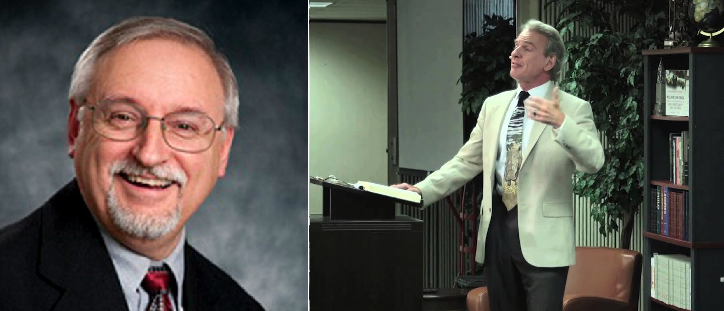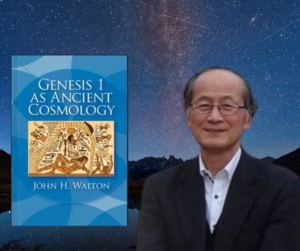In this post, I continue addressing William Lane Craig’s Critique of The Cosmic Temple Inaguration view of Genesis 1 (CTI) defended in books such as John Walton’s The Lost World Of Genesis One. Click here to read the previous blog post. Dr. Craig is interacting with Walton’s book The Lost World Of Genesis One in his Defenders class.
Why Not Both? Why Not Both? Why Not Both?
First, Craig rightly points out that “days 1 to 3 establish various functions, and then days 4 to 6 establish functionaries, that is to say things that will carry out the functions established on days 1 to 3. So there is a kind of parallelism here such as we saw in the literary framework view but it’s interpreted differently. Walton argues that days 1 to 3 serve to establish the basis for time measurement (day and night), weather (the waters above and the waters below), and then food (the vegetation).” but then argues that while we don’t need need to dispute the point that those things are created for these purposes, this fact does not imply that the creation (material creation) of the dry land, the firmament, and the vegetation is not also affirmed along with the specification of their functions.
This is the point that Craig brings up ad nauseum. Why can’t it be both material and functional? As I pointed out in the last blog post response, Walton would somewhat agree that it could theoretically be both. Theoretically, there could be both material and functional creation, in the text, at least if all you’re doing is examining verb uses (i.e bara and asa, create and make). However, Walton and I are both skeptical that both are present in the text on the basis of the following reasons.
Reason 1: This is not a point that Walton makes, but I, Inspiring Philosophy, and Michael Heiser would all argue that God’s first creative act is in verse 3 rather than in verse 1. This is because verse 1 is an independent clause. Because there is no definite article, it should be translated “When God created the heavens and the earth” rather than “In the beginning, God created the heavens and the earth”. Translating verse 1 this way makes it a dependent clause, which then makes verse 2 a circumstantial clause, which then makes verse 3 the main clause. This structure can be seen in other Ancient Near Eastern creation texts such as Enuma Elish and Atrahasis. This means that when God shows up, so to speak, to create the heavens and the earth, the material is already present! “The earth was formless and void. Darkness was over the surface of the deep.” Where the earth come from? Where did the deep come from? Genesis doesn’t say. Wouldn’t a material origins account begin with no material?
Reason 2: Day 2 has a potentially material component (i.e the firmament) but, “if this were a legitimate material account then we would be obliged to find something solid up there.” If we take Genesis 1 as an account of functional origins, then we are not obliged to find a solid dome up there. Craig takes Walton to task in making this objection, accusing him of resorting to concordism to support CTI! Craig misunderstands Walton’s point though. In his book, Walton made this point as a reductio ad absurdum to people like Craig who insist that Genesis 1 must be talking about material creation. If it’s about material creation, then you do have to say that God actually, physically made a solid dome in the sky. But no scientifically literate person could believe such a thing. So, two other options are available: interpret raquia (the Hebrew word translated as firmament) in a way that would be foreign to an Ancient Near Easterner (as is typical of concordists like Ken Ham and Hugh Ross, for examples) or accept the CTI view. In other words, William Lane Craig needs to pick his poison.
Reason 3: Days 4 and 6 deal explicitly only with material components on a function level.
Craig responds to this by saying “This might be the case for the sun, moon and stars admittedly, but it’s clearly false for the animals when God says, Let the earth bring forth living creatures. And it’s probably false for man as well when God says, Let us make man in our image, since man was not among the animals. He didn’t exist at that time, and so needed to be created by God. So I think that days 4 and 6 do deal with the creation of material objects and not just functions.”
Why think that it’s “clearly false” though? Just because the text says “let the earth bring forth living creatures?” But what if God is assigning the function of the earth? That’s the earth’s job: to bring forth living creatures. That’s its function. That’s what God hired it to do, so to speak. We need not see this as the original material creation of animals unless we come to the text presupposing that Genesis 1 is about material origins. Craig once again begs the question against CTI. As for man, the text says “Then God said, ‘Let us make mankind in our image, in our likeness, so that they may rule over the fish in the sea and the birds in the sky, over the livestock and all the wild animals, and over all the creatures that move along the ground.'” (Genesis 1:26, emphasis mine). Well, would you look at that? Functions! Man’s function is (including but not limited to) ruling over the fish in the sea, the birds in the sky, and the land animals.
Also, what does Craig mean that the functional view is probably false for man because the man didn’t exist at that time and needed to be created by God? Yeah, the man was not functioning in the cosmic temple prior to being assigned a role, but he existed in a material sense. It seems Craig is again begging the question in favor of material creation.
When Craig says “Finally, objection number four is that on day 5 functions are mentioned and the Hebrew word for create (bara) is used. Answer: Bara is efficient causation – the production of the effect. And the material origin of birds and sea creatures on day 5 is clearly in view. Again, the creation of material objects like birds and sea creatures doesn’t require that God created them ex nihilo.” he is again begging the question. Bara has already been demonstrated to not always be about material creation (which he calls “efficient causation” here, illegitimately applying Aristotelian categories to a pre-Aristotelian text). Psalm 51:10, Psalm 89:12, Isaiah 45:7, Isaiah 65:18 are just a few examples in which bara is used and no material is produced. There are times bara could mean
material creation, the problem is that there is never a time it necessarily has to mean that. It’s ambiguous. But there are times where it necessarily cannot mean material creation (e.g Psalm 51:10, Psalm 89:12, Isaiah 45:7, Isaiah 65:18,), so Kenneth
Matthews and John Walton would say “Okay, then it’s not about material creation. It’s about assigning functions.”
If you have places where it can’t possibly mean material creation, and you never have a time where it has
to mean material creation, and there’s plenty of ambiguity in between, you’re likely going to conclude that Genesis 1 is likely not material creation. Especially when functions are explicitly stated day after day after day.
“Then God said, ‘Let the land produce vegetation [i.e the function of the land should be to produce vegetation]: seed-bearing plants and trees on the land that bear fruit with seed in it [i.e the function of the vegetation is to produce food], according to their various kinds.” And it was so. The land produced vegetation: plants bearing seed according to their kinds and trees bearing fruit with seed in it according to their kinds [i.e The function was assigned just as God commanded]. And God saw that it was good. And there was evening and there was morning, the third day.” – Genesis 1:11-13
“And God said, ‘Let there
be lights in the vault of the sky to separate the day from the night,
and let them serve as signs to mark sacred times, and days and years,
and let them be lights in the vault of the sky to give light on the
earth.‘ And it was so. God made two great lights—the greater light to
govern the day and the lesser light to govern the night. He also made
the stars. God set them in the vault of the sky to give light on the
earth, to govern the day and the night, and to separate light from
darkness. And God saw that it was good. And there was evening, and
there was morning—the fourth day.” – Genesis 1:14-19 (emphasis
mine)
Objections To Viewing Genesis 1 As A Temple Account
In Genesis 2:2-3 we read, “And on the seventh day God finished his work which he had done, and he rested on the seventh day from all his work which he had done. So God blessed the seventh day and hallowed it, because on it God rested from all his work which he had done in creation.”
On Walton’s view and mine, this text says God’s resting on the seventh day indicates that God comes to rest in the cosmos as His temple. The seven days of the creation week were the inauguration of God’s cosmic temple. The inauguration ceremony consisted of assigning functions to everything, determining how everything would work for humanity and ultimately, for God, in His temple.
Craig’s objections to viewing Genesis 1 as a temple account are as follows
1: “God doesn’t need to rest because he hasn’t been creating anything during the previous six days, and therefore this notion that resting must equal residing is a result of this functional interpretation. Since God hasn’t been working, he cannot cease from working on the seventh day, so it’s simply his residing in the temple which is read into the text and is dependent upon this functional interpretation.”
This is perhaps the worst objection Craig has brought up so far. God wasn’t doing anything? Does he hear himself? God was assigning functions to time, weather, food, sea creatures, animals, and humans. Just because God wasn’t materially bringing these things into being doesn’t mean he was doing nothing. Has a king done nothing when he determines the roles his subjects will have in his kingdom? There’s no way to sugar coat it, this objection is just plain awful.
He was working. He was assigning functions. Here’s what John Walton says in his NIV Application Commentary On Genesis; “The seventh day is marked by God ceasing the work of the previous six days and settling into the stability of the cosmos he created, perhaps experiencing refreshment as he did so.”
2: “To justify his interpretation, Walton has to go outside of Genesis since it’s not in the text of Genesis, which is, I think, in and of itself a dubious procedure.”
Of course you’re going to look at the cultural context. Why wouldn’t you look at the cultural context? If you’re going to read a text that’s thousands of years old and that comes from another country, you had better understand the literature of that time period and area so you know how they thought and don’t impose your own cultural presuppositions onto the text. As Inspiring Philosophy pointed out in his own response to Craig, Craig’s objection is tantamount to saying “How dare you go outside The Declaration Of Independence to understand it by going to the federalist papers?” Of course you would do that! John Locke can provide some light on The Declaration Of Independence. It’s a part of the cultural context. Likewise, looking at other documents of the time and geographic location that Genesis was written can provide some light on the cultural themes of Genesis 1.
So, I don’t think it’s at all a “dubious procedure”. When you do go to the ANE texts (not to mention other places in The Bible), you do find support for seeing God’s resting on the seventh day as God taking up His residence in a temple.
Many creation texts describe the absence of a temple as a major part of the pre-cosmic condition. This is clearest in the preamble that concerns the founding of Eridu.
“The holy house, the house
of the gods, in the holy place had not yet been made; No reed had sprung up, no
tree had been created. No brick had been laid, no building had been set up; No
house had been erected, no city had been built; No city had been made, .no
creature had been created. Nippur
had not been made, E-kur had not been built; Erech had not been created, E-ana
had not been built; The Deep had not been created, Eridu had not been built; Of
the holy house, the house of the gods, the habitation had not been made. All
lands were sea. At that time there was a movement in the sea; Then was Eridu
made, and E-sagil was built, E-sagil, where in the midst of the Deep the god
Lugal-dul-azaga 1 dwelleth; The city of Babylon was built, and E-sagil was
finished.”2
Then Marduk settles the gods into their dwelling places, creates people and
animals, and sets up the Tigris and Euphrates.
In a prayer to dedicate the foundation brick of a temple, it is obvious that the cosmos and temple
were conceived together and thus are virtually simultaneous in their origins.
“When Anu, Enlil, and Ea
had a (first) idea of heaven and earth,
They found a wise means of providing support of the gods:
They prepared, in the land, a pleasant dwelling,
And the gods were installed in
this dwelling: Their principle temple.” 3
3: Isaiah 66:1 is a verse that Walton uses to support his view. However, Craig thinks it actually undermines his view! Isaiah 66:1 says “Thus says the Lord: ‘Heaven is my throne and the earth is my footstool.’” Doctor Craig says “I don’t think that that supports Walton’s view at all! What it says there is that it is heaven that is where the throne of God is (where God is seated), and the Earth is just his footstool.” So? According to ANE cosmology, Heaven was a part of the cosmos. The ancients believed in a three tiered cosmos. The first heaven was the solid dome firmament, underneath which the birds would fly. The second heaven is where the cosmic waters existed. The third heaven was God’s throne. It was the place disembodied souls went to await the bodily resurrection.1 Now, Craig seems to be viewing the text through modern evangelical lenses, thinking of “Heaven” as a supernatural realm apart from our physical universe. I think it is correct theologically to view Heaven as not part of our physical universe, but we have to understand that the ancient Israelites didn’t see it that way. To them, Heaven (i.e the third heaven where God’s throne is) is a part of our universe.
I also want to point out that Craig omits the last half of Isaiah 66:1 which is arguably the more relevant portion “where is the house that ye build unto me? and where is the place of my rest?” The reference to God’s ‘rest’ as parallel to taking up residence in His temple is the main point Walton makes out of this passage, and Craig just seems to skip over it. Why? Only God knows.
4: Craig’s fourth objection is that God had a temple, but that it was in Jerusalem, and he cites Psalm 132 to make the point, ironically a verse Walton uses in support of his interpretation. But I don’t see how God having a localized, literal physical temple in Jerusalem precludes God having the universe as his cosmic temple. Indeed, Solomon seemed to recognize that the cosmos was the true temple in God in 1 Kings 8:27, 30:
“But will God indeed dwell on the earth? Behold, heaven and the highest heaven cannot contain thee; how much less this house which I have built! . . . . And hearken thou to the supplication of thy servant and of thy people Israel, when they pray toward this place; yea, hear thou in heaven thy dwelling place; and when thou hearest, forgive.” (KJV)
In other words, Solomon seemed to be saying that God’s glory was just too much for a man made temple to handle. God is infinitely greater than the gods of the pagan nations, so unlike them, He cannot be so confined. Instead, when people plea to God, He will hear from “heaven”. Again, think like an Ancient Near Eastern person. Heaven was part of the cosmos in their view. Ironically, this very same passage I cited is one Craig uses in his attempt to refute CTI, but I actually think it reinforces the point, albeit subtly.
Conclusion
Craig has failed at refuting CTI. I still find CTI to be the most likely interpretation of Genesis.
—————————————————————————-
NOTES
1: All of this information can
be checked out in Kyle Greenwood’s book “Scripture and Cosmology:
Reading the Bible Between the Ancient World and Modern Science,” Part
1 of Greenwood’s book walks through each “tier” of the ancient universe, from
heaven to earth to sea to underworld. He presents historical and archaeological
evidence from the world of the Bible—the “Ancient Near East”—and shows how this
cosmology influenced the biblical writers. This ancient understanding of the
cosmos is not only talked about in “Scripture and Cosmology: Reading
the Bible Between the Ancient World and Modern Science,” by Kyle
Greenwood, but also in “The Firmament and
The Waters Above”, by Seely P, in the Westminister Theological
Journal, 54, 1992, pages 31-46,
3: As cited in The Lost
World Of Genesis One: Ancient Cosmology and The Origins Debate by John
Walton, page 79, IVP Academic.





I’m surprised your comments section isn’t blowing up since Craig has addressed this blog post in his last two podcasts. I still don’t think Craig understand’s Walton’s (and your) perspective on this. Would love to read a follow-up.
I agree. I am getting a lot of page views, but not many comments. Then again, I typically get more page views than I do comments. That has been the case for years.
I think the reason why William Lane-Craig is not understanding John Walton’s view is because he thinks Walton is claiming that God actually had a 7 day temple inauguration at some point in time 🙂 But Walton isn’t saying that. Walton is only saying that Genesis 1 is based on the format of an ancient temple inauguration. The Israelite author is using a commonly understood inauguration procedure to show how Israel”s God created the universe to be his temple. The function proclaiming nature of such an inauguration is all over Genesis 1.
Really? I took it to mean that it happened at some point in time as well, coming after the material manufacturing process. The reason I view it that way is that the things in question are said to function FOR humanity, and obviously you can’t have a cosmos functioning for humanity unless humanity has already been created materially.
But now that I think about it, you could view this as similar to how Proclamation Day Theorists view the texts (as taking place outside of time), but just putting functional creation in place of material creation. There’s certainly no requirement to see it as taking place over 7 day period thousands of years ago. I think you’re correct to point out that Cosmic Temple/Functional Origin advocates have wiggle room to say whether this literally occurred over a 7-day period, that it was a metaphor. Perhaps, to put an Augustinian Flavor on it, taking place in a single instant or even outside of time altogether.
To be fair, as I gloss over Walton’s Genesis One book a second time (and I need to do it in more detail), it’s not very clear whether he is saying the 7 days are based on ancient human inaugurations or ancient human inaugurations are based on one cosmic divine one. To be honest, the former one is the only one that would make any sense to me! A divine event seems so theoretical. I mean; where was it, who was invited? And we must remember that Walton is an accomodationist, and so I would anticipate that he sees Genesis one as ‘accomodating’ an ancient inauguration layout. But admittedly (from what I can see) the book is not very black and white on this. In Proposition 9 Walton suggests that Genesis one was a 7 day layout (or liturgy) for an annual Israelite event. This speaks strongly of it being purely a literary construct. But at the end of Proposition 11 he seems to say it’s not just a literary construct (perhaps he means it is literary but it has better support than the Literary Framework view). Personally I think Walton’s view makes all the sense in the world, if and only if, it is based on the accommodation of an ancient temple inauguration. But he would have to be the referee on this.
I am also an accommodationist. Concordism, as Walton says, has no reliable controls. While I would agree with concordists that The Holy Spirit could have an additional meaning to a text in mind (we see a lot of this with repurposing of OT verses in the NT), the problem is that every generation could make the scriptural texts fit their own scientific paradigm and until new science comes along, one says “Well, I guess this passage isn’t really referring to (insert scientific theory) after all.” The only way I’d be comfortable in attaching a scientific theory to a biblical passage is if we had an additional divine revelation; a New-New Testament if you will, that says “Yep, stretching out the heavens is referring to the expansion of space.”
–
Who would be invited to a temple inaguration ceremony? I think The Divine Council Worldview could easily answer this; the sons of God and the angels! Of course, if the inaguration actually takes place chronologically after everything is materially manufactured, then even human beings could be invited.
–
I remember what Walton says in the earlier propositions more than in the later ones, but if memory serves, I think by “literary construct”, he was referring to the view that sole purpose of the chapter was to assert the sovereignty of God in the creation and refute their pagan neighbors. Of course, I do believe a polemical aspect is a part of it (which Walton seems to disagree with). My view is that Genesis 1 is both a temple inauguration ceremony and the author words certain things in such a way as to take jabs at other gods (e.g calling the sun “the greater light” and the moon “the lesser light” because the Hebrew words for sun and moon were also the names of gods said to represent those celestial bodies).
I think the reason why so many have welcomed John Walton’s view, including scolars like NT Wright, Is because they consider it to be literary accomodation. I think they see that Walton isn’t claiming that God had a 7 day inauguration, but that the 7 day creation account is based on the format of a 7 day inauguration. Once Lane-Craig spots this, he will see that the apparent dichotomy between material and functional creation is non-existent. Personally, I think Walton has hit the nail on the head!